In Stephen King’s novel he dies in a boiler explosion inside The Overlook, but nothing that simple happens here. In another undeniable Kubrickian reversal of the source novel at the end of the movie we see him frozen solid outside of The Overlook. But what may have been also included in the first directors cut, and later removed, is that his body couldn’t be found by the police. This is very important. His body just disappears and to answer the question we should look at something else first; was Jack ever in the hotel before?
What would lead us to believe Jack’s been to The Overlook before as he definitely wasn’t there before in Stephen King’s novel? Early on he says this to Wendy, “It was as though I had been here before” but this statement doesn’t really prove anything. Grady’s famous line, “I'm sorry to differ with you, sir, but you are the caretaker. You have always been the caretaker, I should know, sir. I've always been here” cannot be used as proof that Jack’s returned because his visions of Grady are a product of his own imagination, combined with his growing madness coupled with his ability to “Shine”. If The Overlook is speaking to him through Grady it can’t be believed because as Danny states in Stephen King’s novel, “The house always lies”.
Then we see it! Jack appears standing in The Overlook in the last picture of the movie dated July 4th 1921. Ask anybody who’s seen "The Shining" if Jack Torrance has ever been there before and they will all use this picture as the one irrefutable example of it.
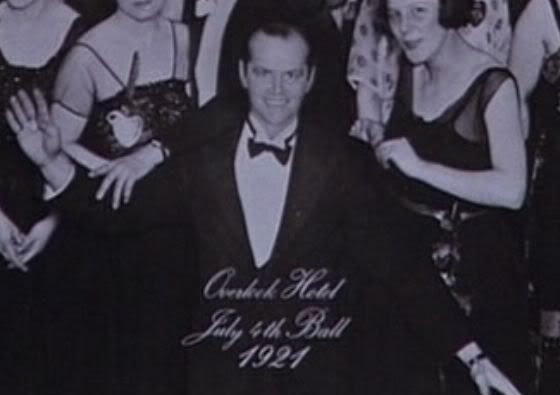
“Of course he was, I’ve seen a picture of him with a date under it from 1921, I’m absolutely sure of it, it has to be; Are you f’ing crazy?” The audience has been masterfully manipulated, this is just too easy. On the surface the picture is just to easy to interpret and as I’ll show you Stanley Kubrick’s put specific suggestions in our heads throughout the movie; Jack has never been in the hotel before, hasn’t returned, and isn’t Grady reincarnated. No matter how hard you say, “I believe, I believe” it just isn’t so; we’ve been manipulated by a master.
Any serious discussion of this film must address what happens in the last scene and can’t be considered complete without it. We’ve seen throughout the movie that whenever someone “Shines” something moves, changes color or disappears whether inside or outside of The Overlook. Just about all of the props in the last shot except the ceiling and floor have changed, and this alters everything because the question has to be; Who did it now? The cast members have all gone. But you must ask yourself; am I the one seeing the vision this time with the song "Midnight, The Stars and You" playing in my ears?
The chairs are now covered maybe indicating that “The Caretaker” is gone and there are more no invisible entities sitting around on them. The Gold Room sign moves across the floor from left to right but hasn’t changed with the same 2 artist’s pictures on it (indicating to me that we’re still in the present time frame and not in the past, or in some recurring BS sci-fi time warp).


The 2 mirrors on the sides of the 21 pictures are gone, replaced by Indian artwork, and the red couch, another place to sit, has now disappeared.
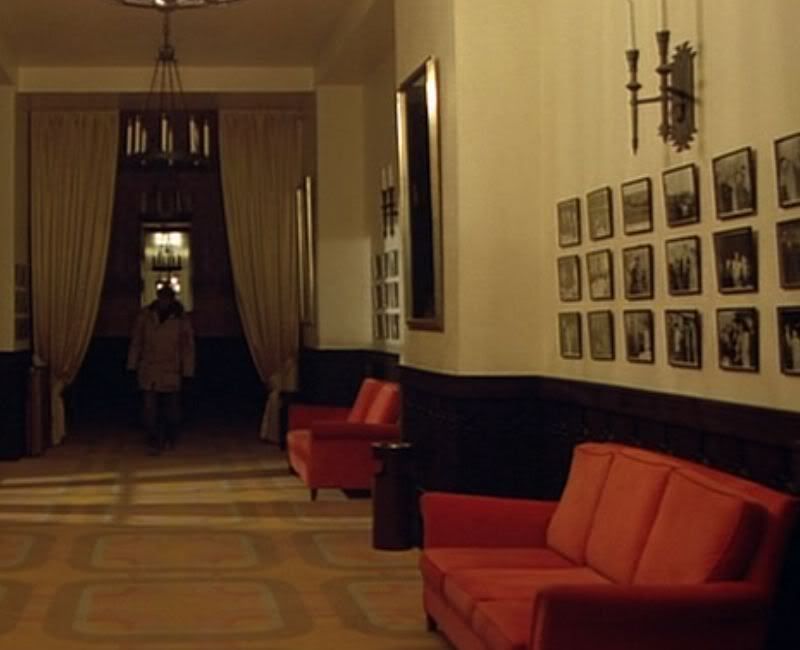
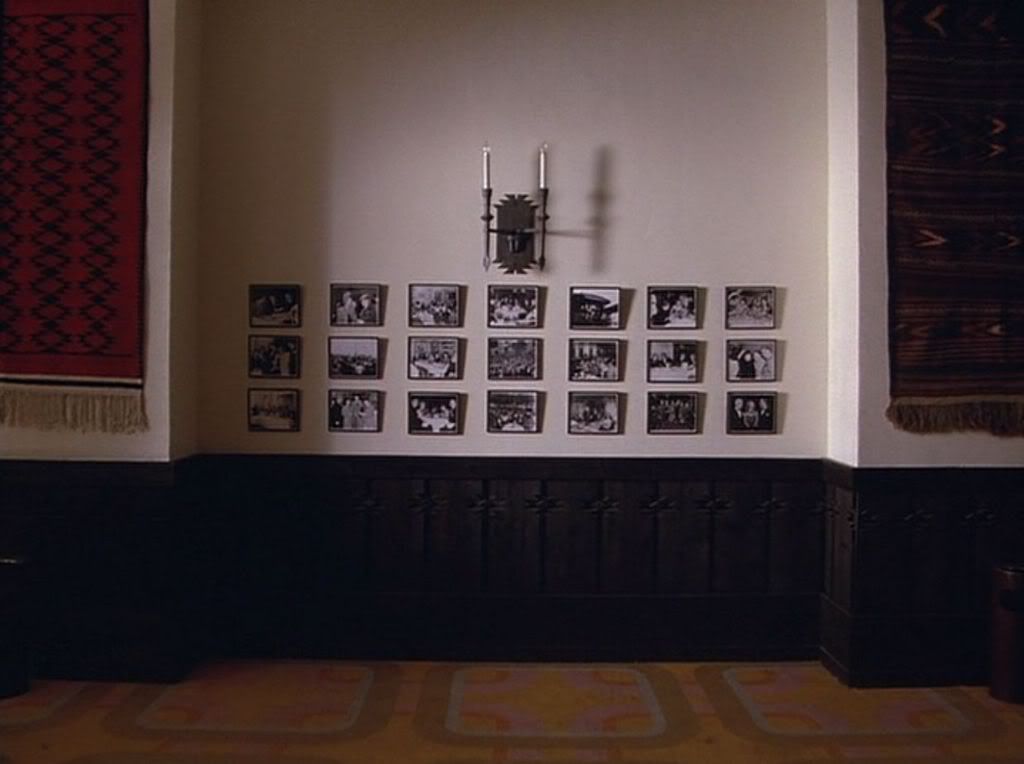
Lastly, don't forget there’s the most important alteration in the whole movie (maybe of any movie ever), the 21 pictures on the wall. They’re entirely different from what was in this spot when we’ve seen it several other times throughout the movie and the most puzzling image of all time dead center, “Overlook Hotel July 4th Ball 1921”, just wasn’t there before this last shot of the movie. No one ever noticed this. How could all the pictures be different?
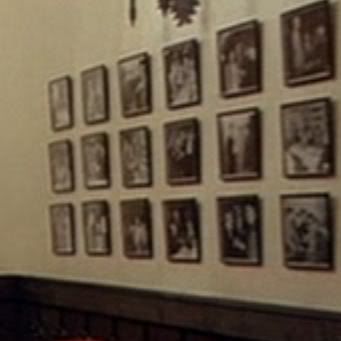
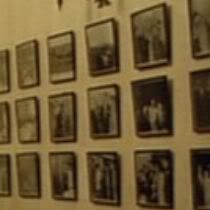
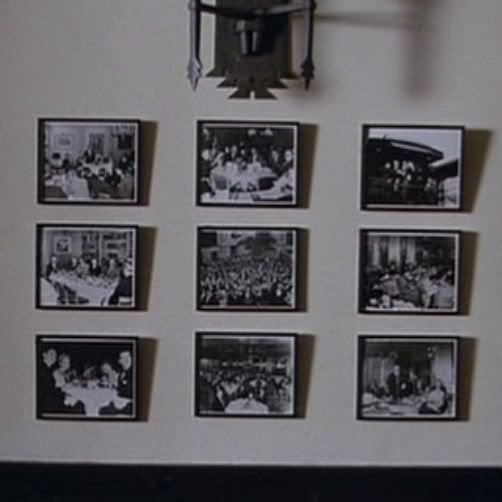

Anyone who doesn’t realize by now that all the cast members in this movie have a very special ability may be hopelessly thick. They can see visions, speak together telepathically, change the colors of possessions and surroundings, and they can move objects without touching them. This is what the movie is about and it’s obvious someone used this special power and “Shined” that picture onto the wall at the end of the movie, but everyone in the story with the power is either dead or has left the building; Do you know who did it this time?
Stanley Kubrick has added yet another brilliant twist to this movie (maybe the greatest hidden twist in movie history); In the end as the camera zooms in on the center picture we, the audience, are the only ones there in the lobby, and we become an integral part of the movie. Jack was never in The Overlook in 1921 but we, never realizing that it’s us doing it, “Shine” him to the spot on the wall where we believe he was and belongs; back into the Overlook’s past. In the end he doesn’t exist anymore. Nothing more, nothing less. We’ve turned him into just a picture on a wall. Now he’s where he belongs, in the Overlook, frozen for all time, “for ever and ever and ever”. Throughout this entire movie we’ve been guided by the art of Stanley Kubrick’s simple suggestions and are unshakenly positive in our belief that Jack Torrance was in a past life, Grady, The Overlook’s caretaker. In the end, again, we’re seeing a reflection of what we thought was real. Anyone who erroneously tries to explain why this picture, the most enigmatic prop in movie history, isn’t there for 99% of the movie as a movie mistake or continuity error is insulting Mr. Kubrick’s intelligence, and just doesn’t get this movie. This must have a valid and plausible explanation. No one would go through the trouble of finding an authentic picture from 1921, as stated in his interview with Michel Ciment, and then forget to hang it up till the end of the movie. Come on, get real. Jack was never there before, but he sure is now, “for ever and ever and ever”; and you did it.
There’s a classic episode of “The Twilight Zone” from 1961 that reminds me of all this, and I bet Stephen King or Stanley Kubrick must have seen it. In “It's a Good Life”, Billy Mumy plays a child who has a special power that will look very familiar if you ever get to watch it. He’s totally evil and is able to transform people he doesn’t like into inanimate objects at will. If you ever get to see this episode you’ll know why the picture isn’t there for most of the movie and what power transformed the 21 pictures on the wall in the end. It will also become very clear who did it.
But it’s so obvious; Jack’s been reincarnated. Everyone believes he’s been in The Overlook before. This is the enormous power held in this one enigmatic image. The image of Jack standing there is almost like a religious icon. There’s a weird kind of faith people have in it, that it’s telling us he’s been in The Overlook before. It's unshakable. The audience must be aware of the visual inconsistencies contained in that picture though. They can’t be explained away or ignored, and I believe they prove that he’s never been there before.
Unfortunately Stanley Kubrick will be no help whatsoever in trying to understand what’s going on in the end of “The Shining”. Look carefully at what Stanley Kubrick said about this scene in his interview with Michel Ciment. He could have told Michel exactly what the ballroom picture means, but instead he cleverly says this; “The ballroom photograph at the very end suggests the reincarnation of Jack”. What an interesting choice of words he uses as the definition of ‘suggests’ is to cause one to think that something exists. The implication here is obvious. He wants Michel Ciment, as well as the rest of us, to “think that something exists” or else he simply wouldn’t have used that word. Everyone is positive they have the answer to the most puzzling question in this movie because the power of this one image, and what it says, is unbelievable. But look closely at Jack in the final picture. The Overlook's caretaker worked in the winter. It’s a total paradox. July 4th is in the summer and Jack wouldn’t have been there. He isn’t the caretaker in that picture either if you look closely he’s The Manager. It isn’t even July 4th, as the only identifiable object seen there would obviously make us think of a New Year’s Eve party. Unless you're someone who uses New Years Party favors in the summer. And what happened to all the other caretakers that had to have worked in between and before Jack and Grady?

It can be just as powerful in a movie but we see this in life all the time; the amazing power of a single image.
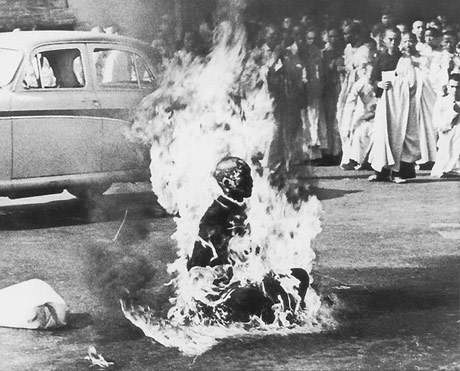

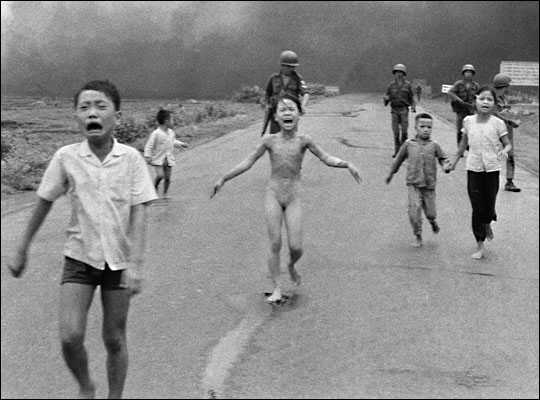

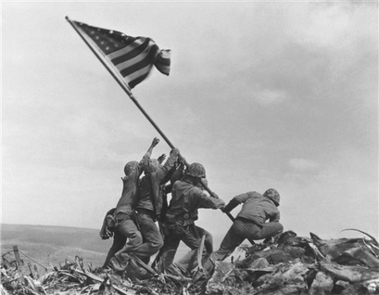
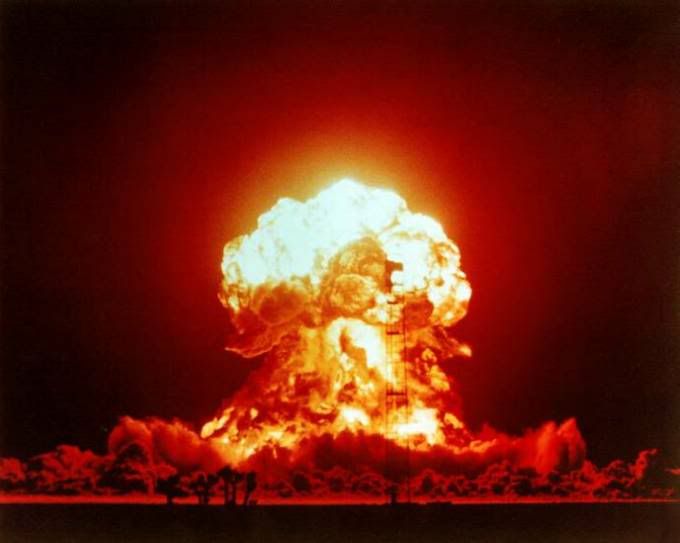
Stanley Kubrick purposely created a cinematic enigma that he knew viewers would be trying to understand for a very long time. In a beautifully simple way he made it as hard as possible to figure out because the more you look, the more you notice. And the more you notice, well…. No one can argue this fact though; he released a work that looked exactly the way he wanted it to. It was planned out ahead of time and what we see on the screen was placed there purposely. It is what it is. What we see can’t be changed and has to be the foundation of any attempted explanation.
If you just want to enjoy “The Shining” on a basic level what I’ve shown here won’t matter to you, but if your desire is to delve into a deeper understand of this work you’ll need to look very carefully at this picture. I stated before I don’t believe Jack’s ever been in The Overlook before. It’s the reverse of what everyone else believes but everything needed to prove my seemingly outrageous statement is there in the picture. It must be looked at and any examination of the last shot in “The Shining” that doesn’t acknowledge or attempt to explain these three obvious facts is intentionally incomplete.
The first problem as I stated before is the definition of reincarnation; the rebirth of a soul in a [new] body. Jack is still in the same body and this can’t be changed; by the very definition he hasn’t been reincarnated. Second, there’s one glaring problem with the July 4th picture that hardly anyone has ever realized, yet can’t be ignored. If Jack is the reincarnated caretaker from the Overlook’s past, or for that matter if he has ever been there in a previous life, than the picture had to have been taken in The Overlook. It may say “Overlook Hotel July 4th Ball 1921” but the party depicted in the picture quite simply isn’t in any room of The Overlook. We’ve seen all the big rooms in the hotel and there's absolutely no indication of another one either in the movie or the novel. This is no mistake. It’s such a brilliant yet simple deception. Stanley Kubrick makes us believe the photo was taken in The Overlook by what’s written on it. Anything can be written on a picture but it doesn’t make it true. Kubrick aficionados can jump up and down, throw tantrums, spit blood, or spin their heads like Regan from the Exorcist, but it will not change a thing. The place depicted in the picture is just not The Overlook. Stanley Kubrick planned it this way and this picture simply cannot be used as proof that Jack has ever been in The Overlook before in this or any other lifetime because it’s obvious, the picture has been taken somewhere else. The “somewhere else” Stanley Kubrick may have had in mind might be an interesting thing to ponder though.
Again we must return to what I showed you before. The third and most important thing about this picture that I bet you never noticed until now is; it’s not there on the wall at any other time in the movie. The most enigmatic prop in movie history just appears on the wall in the last shot? I believe someone “Shined” it up there. After all “Shining” is what this story is about, not reincarnation and there’s not a shred of evidence that any supernatural power other than “Shining” is going on here. Something else happened to Jack Torrance at the end of this story. We still see him in the same body; it’s not reincarnation as the definition of the word is very precise. Jack's never been in The Overlook before and the final picture wasn’t there earlier in the movie because, in the story’s time line, what it depicts simply hasn’t happened yet. It’s our vision of Jack’s future that Stanley Kubrick made to look like the past, and it happens at the very end of the story when all the cast members with this power are gone. He’s been frozen again a second time, for the rest of time. “Shined” onto a wall in a hotel where he will be “for ever, and ever, and ever”.
Look at all the major reversals Stanley Kubrick made to Stephen King’s story. In the novel Jack burns to death, The Overlook is destroyed and no one remains there. In the movie The Overlook is not destroyed, Jack is frozen and remains there on the wall forever. It’s obvious, but old perceptions die-hard and again a knee-jerk explanation for all this is that the picture has mistakes in it. But Stanley Kubrick doesn’t make “mistakes” like this without a reason and anyone who thinks he does should be prepared to prove how they know this for a fact. “The Shining” was released looking exactly the way he wanted it to. We’re looking at a brilliant deception. Everyone thinks they see people attending a party back in 1921. The picture looks like the past but we don’t even know for certain whether it’s past, present, or future; or what it actually depicts. The question that’s never asked is “who are the people in the picture?” Maybe it’s a get together of previous “Shiners” who visited The Overlook in the past. If you look closely all the sofas do disappear as the movie progresses – no place for their Doppelgangers to sit. When you read the next section of my blog you’ll understand why I believe the picture is not only there in the end but might actually depict a different type of end; a future gathering in hell. Whether you like his character or not Jack took a major wrong turn in life.
I mentioned before Stanley Kubrick’s obvious manipulation of time codes in this movie. If you look closely the shot where Jack gulps down his first drink is exactly 66 minutes and 6 seconds into the movie. Could this have just happened by chance? It’s undeniable the time code is exact to the second from when the story starts after the :11-second Warner Brothers logo is finished. If you don’t believe me “go check it out” for yourself.
In the last picture if Jack has become, as I believe, The Manager or the Master of Ceremonies in hell the people with him may very well be other “Shiners” who, like Jack, have passed through life and taken a similar wrong turn. It’s not The Overlook in the picture though, that’s not where they’re gathered. The picture may have ended up on The Overlook’s wall but they are definitely somewhere else.
You may still feel Jack’s been in the hotel before but think about this. There’s something in the dialog that proves Jack in the present day Overlook could not be a reincarnation of Charles Grady who killed his family and himself. Listening to the bathroom conversation between the two Charles Grady and Delbert Grady appear to be, on the surface, the same person, but they actually aren’t. Stanley Kubrick gave them two different names for a reason; they’re two different entities. One is a vision and the other is a real person. There should be no confusion about this; Delbert Grady is a vision inside Jack’s head that looks exactly like the real Overlook caretaker, Charles Grady. We know this positively from the dialog Stanley Kubrick put in the movie. Jack says this as he speaks to him in the bathroom, “Mr. Grady. You were the caretaker here. I recognize ya. I saw your picture in the newspapers.” There’s something here that movie viewers who have never read the book are not aware of. When Jack says, “I saw your picture in the newspapers” he’s referring to the unexplained scrapbook that we see open on his desk throughout the movie. The scrapbook plays a big part in the novel as it’s in the basement and used by “the manager” to lure Jack. It contains articles about the hotel and Jack eventually decides to use it to work on a different project about The Overlook’s past. When he says, “I saw your picture in the newspapers” he already knows what Charles Grady looks like. You don’t know what Grady looks like, but Jack does. Delbert Grady, “the ghost”, and Charles Grady, “the caretaker”, look exactly the same and Jack knows this for sure. He’s imagining talking to the same Charles Grady that he’s seen in the newspaper clippings who killed his family and himself in 1970. But there’s a major problem here; there can’t be any reincarnation of these two people because of what we know from the interview with Mr. Ullmann. We know when the two little girls were killed. Jack and Charles Grady, when he worked at the hotel, are both alive at the same time in 1970. The party is all a vision we’re seeing from Jack’s imagination. Grady may say this line “You are the caretaker, you have always been the caretaker” indicating all the caretakers are the same entity; Jack. But he and Charles Grady were obviously both alive at the same time and this can’t be debated or changed no matter what your opinion is. You can’t be a reincarnation of someone who is alive at the same time you are.
This perplexing picture is the final vision in a movie that’s full of visions. It’s by someone who has the exact same ability to “Shine” and see visions as The Overlook’s previous guests, the Torrences and Dick Hallorann who we know in the end are all either dead or like Elvis have "left the building”. The hotel is now empty except for us, the audience. Just think of how brilliantly this was put across in Stanley Kubrick’s script by Dick Hallorann, the only expert on “Shining” we know of; “But there are other folks, though mostly they don't know it, or don't believe it”. That may be you he's talking about, think about it; you are the other folks that don't know it, or don't believe it. What an unbelievable twist! The power of this one image. The unbelief of realizing that it might not be what it seems. It turns out in the end Stanley Kubrick has taken Stephen King’s story about a little boy who possesses the power to “Shine” and in the end reverses that power by giving it to the audience. Now, in this last perplexing shot as John Lennon sang in the song that inspired the novel.... “We all ‘Shine’ on”!
Several of the mysteries of the movie are explained by the obvious changes Stanley Kubrick made to Stephen King’s novel. Here are the differences between the novel and the movie again.
Click here and go back to my blog with almost 450 interesting pictures from the movie, and read more.